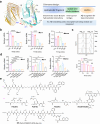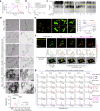Targeting phagocytosis for amyloid-β clearance: implications of morphology remodeling and microglia activation probed by bifunctional chimaeras
- PMID: 40885741
- PMCID: PMC12398596
- DOI: 10.1038/s41467-025-63458-3
Targeting phagocytosis for amyloid-β clearance: implications of morphology remodeling and microglia activation probed by bifunctional chimaeras
Abstract
Amyloid-β (Aβ), a key driver of Alzheimer's disease (AD) pathogenesis, possesses diverse harmful and clearance-resistant structures that present substantial challenges to therapeutic development. Here, we demonstrate that modulating Aβ morphology, rather than Toll-like receptor 2 (TLR2)-dependent microglia activation, is essential for effective phagocytosis of Aβ species by microglia. By developing a bifunctional mechanistic probe (P2CSKn) designed to remodel Aβ and activate TLR2, we show it restructures soluble Aβ (sAβ) and fibrillar Aβ (fAβ) into less toxic hybrid aggregates (hPAβ). Critically, this structural remodeling protects microglia from Aβ toxicity while enabling robust phagocytosis. Moreover, although TLR2 activation mildly enhances Aβ uptake, it concurrently triggers detrimental inflammation that negates its benefits. Our findings establish morphological remodeling as the critical determinant of effective Aβ clearance and suggest a morphology-focused strategy for developing safe therapeutics for Aβ-related diseases.
© 2025. The Author(s).
Conflict of interest statement
Competing interests: The authors declare no competing interests.
Figures







Similar articles
-
Stimulation of α7 Nicotinic Acetylcholine Receptors by PNU282987 Demonstrates Efferocytosis-Like Activation and Neuroprotection in Human Models of Microglia and Cholinergic Neurons under the Pathophysiological Conditions of Alzheimer's Disease.Biol Pharm Bull. 2025;48(7):972-985. doi: 10.1248/bpb.b25-00308. Biol Pharm Bull. 2025. PMID: 40619245
-
Cathepsin B modulates microglial migration and phagocytosis of amyloid β in Alzheimer's disease through PI3K-Akt signaling.Neuropsychopharmacology. 2025 Mar;50(4):640-650. doi: 10.1038/s41386-024-01994-0. Epub 2024 Sep 20. Neuropsychopharmacology. 2025. PMID: 39304744
-
Acute targeting of N-terminal tau protein has long-lasting beneficial effects in Tg2576 APP/Aβ mouse model by reducing cognitive impairment, cerebral Aβ-amyloidosis, synaptic remodeling and microgliosis later in life.Acta Neuropathol Commun. 2025 May 29;13(1):121. doi: 10.1186/s40478-025-02022-y. Acta Neuropathol Commun. 2025. PMID: 40442822 Free PMC article.
-
CX3CL1 Pathway as a Molecular Target for Treatment Strategies in Alzheimer's Disease.Int J Mol Sci. 2023 May 4;24(9):8230. doi: 10.3390/ijms24098230. Int J Mol Sci. 2023. PMID: 37175935 Free PMC article. Review.
-
Microglial activation states and their implications for Alzheimer's Disease.J Prev Alzheimers Dis. 2025 Jan;12(1):100013. doi: 10.1016/j.tjpad.2024.100013. Epub 2025 Jan 1. J Prev Alzheimers Dis. 2025. PMID: 39800461 Free PMC article. Review.
References
-
- Chiti, F. & Dobson, C. M. Protein misfolding, functional amyloid, and human disease. Annu. Rev. Biochem.75, 333–366 (2006). - PubMed
MeSH terms
Substances
Grants and funding
- 81973174/National Natural Science Foundation of China (National Science Foundation of China)
- 82373713/National Natural Science Foundation of China (National Science Foundation of China)
- 22167006/National Natural Science Foundation of China (National Science Foundation of China)
- 82272743/National Natural Science Foundation of China (National Science Foundation of China)
LinkOut - more resources
Full Text Sources

